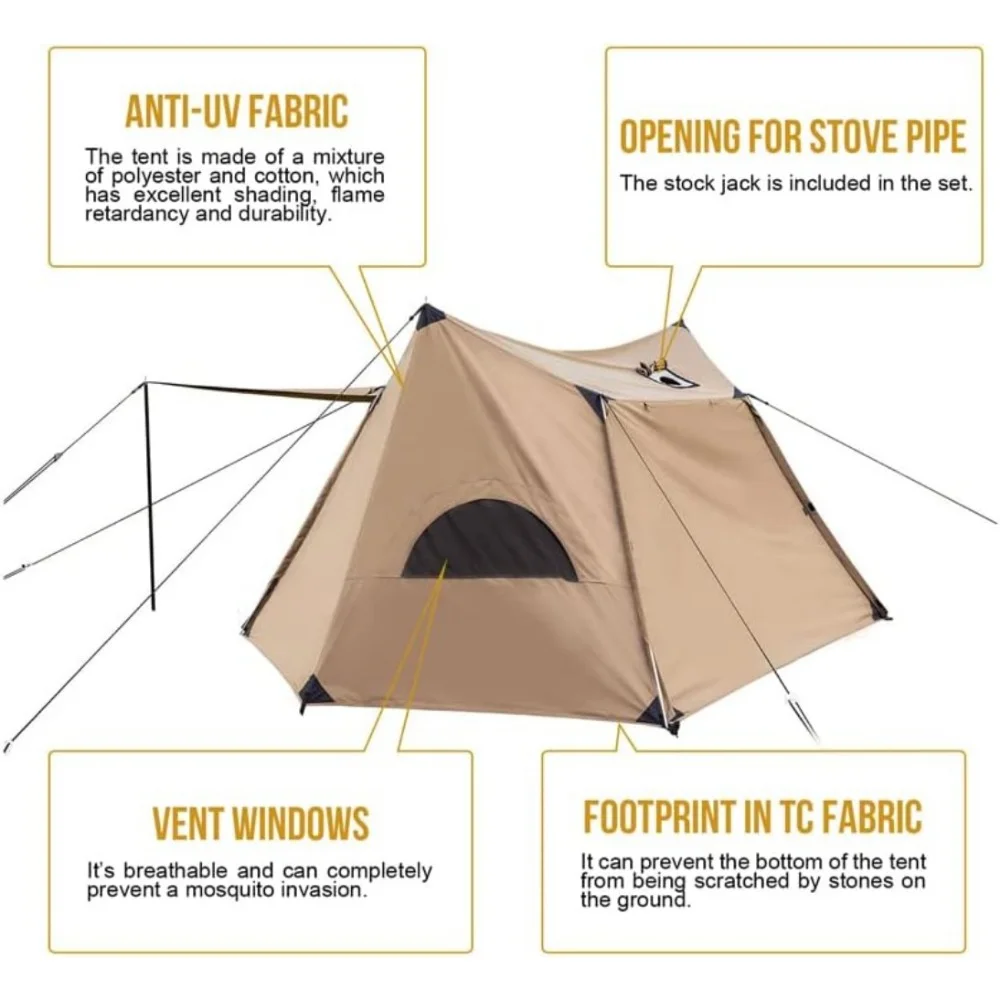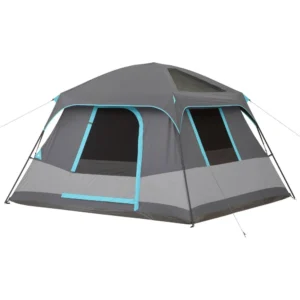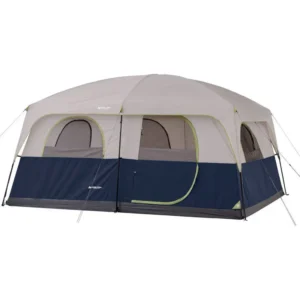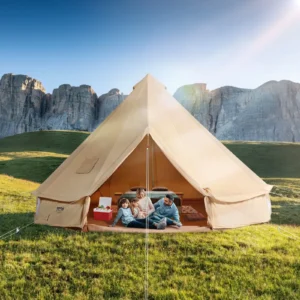1. Why Invest in a Heavy-Duty Canvas Tent?
When it comes to serious outdoor adventures, the quality of your shelter can make or break the experience. Heavy-duty canvas tents represent the gold standard in outdoor accommodation, offering exceptional durability, weather resistance, and comfort that simply can’t be matched by standard camping shelters.
What sets these tents apart is their robust construction – featuring thicker materials, reinforced stress points, and weather-resistant treatments that enable them to withstand nature’s challenges year after year. Unlike typical synthetic tents that might last 3-5 seasons of regular use, a well-maintained canvas tent can easily provide 10+ years of reliable service, making them a wise long-term investment for dedicated outdoor enthusiasts.
The enduring appeal of canvas shelters for rugged camping comes from several key advantages:
- Superior temperature regulation – naturally cooler in summer heat and warmer during chilly nights
- Exceptional breathability – minimizes condensation while maintaining waterproof protection
- Quieter interior environment – canvas dampens wind noise and rain patter for better sleep
- Natural feel and ambiance – creates a more authentic, comfortable camping experience
- Environmentally conscious choice – longer lifespan means less waste over time
While the initial investment might be higher than synthetic alternatives, the extended lifespan and enhanced camping experience make why choose canvas tents for rugged camping an easy decision for those who value quality and performance. Throughout this guide, we’ll explore everything you need to know about selecting the perfect heavy-duty canvas tent for your outdoor adventures.
2. Understanding Canvas Tent Materials: Quality & Construction
Not all canvas is created equal, and understanding the material variations is crucial when investing in a premium tent. Traditional canvas tents are made from cotton duck canvas – a tightly woven, heavy cotton fabric known for its durability and natural weather resistance. Modern options also include poly-cotton blends, which combine the breathable comfort of cotton with added strength and faster drying times from polyester fibers.
Canvas weight, measured in ounces per square yard, is one of the most important indicators of quality and durability. For heavy-duty applications, look for:
- 10oz to 12oz – Standard for quality canvas tents, offering good durability for regular use
- 13oz to 15oz – Heavy-duty options suitable for extended trips and harsher conditions
- 16oz and above – Ultra-durable professional-grade canvas for extreme conditions or permanent setups
The definitive guide to heavy-duty canvas shelters emphasizes that material quality extends beyond just weight. Premium canvas tents typically feature specialized treatments that enhance performance:
- Water-repellent treatments – Silicone or paraffin-based coatings that shed water while maintaining breathability
- Fire-retardant applications – Crucial safety feature that prevents canvas from easily catching fire
- Mold and mildew resistance – Protective treatments that inhibit fungal growth during storage
Construction quality is equally important as material selection. Look for features like double-stitched seams, reinforced stress points at corners and pole attachments, heavy-duty zippers with storm flaps, and properly finished edges to prevent fraying. These details distinguish truly premium tents and directly impact their longevity in challenging conditions.
The breathability advantage of canvas comes from its natural fiber structure, which allows moisture vapor to escape while still repelling water droplets from the outside – a property that synthetic materials struggle to replicate without compromising either waterproofing or condensation control.
3. Frame Systems & Structural Elements
The frame system serves as the skeleton of a heavy-duty canvas tent, providing the structural integrity needed to withstand challenging conditions. Each frame material offers distinct advantages:
Galvanized Steel Frames
– Exceptional strength-to-weight ratio
– Superior stability in high winds
– Excellent resistance to bending and breaking
– Typically 1-inch/25mm diameter for heavy-duty applications
– Protected against rust through galvanization
Aluminum Frames
– Significantly lighter than steel (typically 30-40% weight reduction)
– Naturally corrosion-resistant without additional treatments
– Ideal for more portable canvas tent options
– Generally requires larger diameter poles to match steel’s strength
Spring Steel/Flex-Bow Designs
– Creates constant tension that maintains tent shape
– Self-adjusts during wind to absorb and distribute pressure
– Eliminates the need for constant readjustment
– Provides exceptional stability with fewer poles
Beyond the frame material itself, truly heavy-duty tents incorporate several critical structural elements that enhance performance. Reinforced junctions where poles connect prevent wear and failure at these high-stress points. Heavy-duty guy line attachment points, often featuring extra canvas layers or webbing reinforcement, distribute tension evenly. Ridge support systems prevent sagging under rain or snow loads, while maintaining proper ventilation throughout the tent.
For those interested in exploring various options, our selection of canvas camping tents showcases different frame designs and structural approaches suited to various camping styles and conditions.
The weight capacity of frame systems directly impacts a tent’s ability to support additional equipment like lighting, fans, or storage systems. Premium heavy-duty options can typically handle 30-50 pounds of suspended weight without compromising stability – a significant advantage for extended camping trips requiring more creature comforts.
4. Best Overall Heavy-Duty Canvas Tents
After extensive testing across varied conditions and seasons, these canvas tents stand out for their exceptional combination of durability, weather resistance, and overall quality. Each represents the pinnacle of canvas tent engineering and materials.
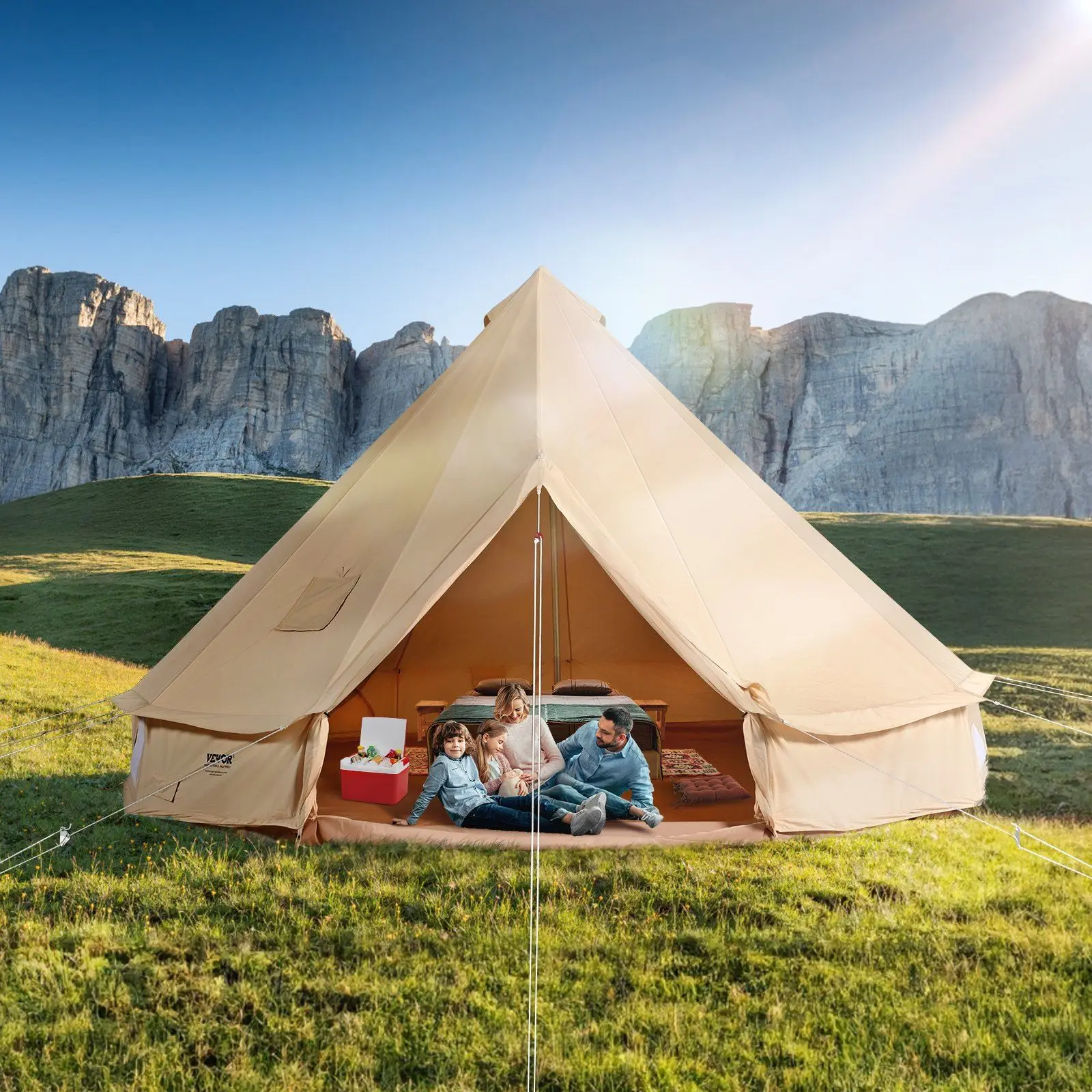
Kodiak Canvas Flex-Bow Deluxe
Key Specifications:
– Canvas: 100% cotton duck canvas (10.10oz)
– Frame: 1-inch galvanized steel tubing
– Floor Area: 100 square feet
– Peak Height: 6‘6” (198 cm)
– Packed Size: 30”x13”x13” (76x33x33 cm)
– Weight: 68 lbs (31 kg)
What Makes It Stand Out:
This tent combines the renowned strength of a flex-bow frame system with premium Hydra-Shield canvas that maintains breathability while shedding water effectively. The silicone dry-finish treatment eliminates the break-in period typically required for canvas tents. Its steep walls create exceptional usable interior space, and the robust floor material prevents moisture intrusion from below.
Considerations:
The weight makes it best suited for car camping rather than backpacking, and setup, while straightforward, benefits from having two people.
Springbar Highline 6
Key Specifications:
– Canvas: 10.10oz cotton duck canvas with water-repellent finish
– Frame: 1-inch steel tubing
– Floor Area: 100 square feet
– Peak Height: 6‘6” (198 cm)
– Packed Size: 28”x14”x14” (71x36x36 cm)
– Weight: 52 lbs (24 kg)
What Makes It Stand Out:
The time-tested Springbar design creates remarkable stability without complex setup procedures. Double-stitched seams and reinforcements at all stress points contribute to exceptional durability, while the unique awning design provides superior ventilation and weather protection simultaneously. The floor features a 16oz vinyl barrier that extends up the sidewalls for outstanding water protection.
Considerations:
Premium materials and construction come with a higher price tag, though the extended lifespan justifies the investment for regular campers.
White Duck Outdoors Alpha Wall Tent
Key Specifications:
– Canvas: 10.10oz Army Duck cotton canvas
– Frame: 1.25-inch galvanized steel
– Floor Area: 144 square feet
– Peak Height: 8‘2” (249 cm)
– Packed Size: 48”x14”x14” (122x36x36 cm)
– Weight: 84 lbs (38 kg)
What Makes It Stand Out:
This wall tent design maximizes usable interior space with near-vertical walls and impressive peak height. The built-in stove jack makes it ideal for four-season camping, while the fire-retardant and water-repellent treatments enhance safety and weather protection. The separate groundsheet design allows for versatile setups based on conditions.
Considerations:
The larger packed size and weight make transportation more challenging, requiring larger vehicles and additional setup time.
For those seeking truly rugged protection in all conditions, these options represent the gold standard in heavy-duty 4-season tents that can withstand years of demanding use.
5. Specialized Canvas Tent Categories
5.1 Best Heavy-Duty Canvas Tents for Extreme Weather
When facing nature’s most challenging conditions, these specialized canvas tents offer exceptional protection and reliability:
Snowtrekker ExpeditionX Canvas Hot Tent
This expedition-grade tent features 10.10oz marine-treated canvas with a specially designed snow-shedding roof angle that can handle up to 24 inches of fresh snow. The reinforced frame system withstands 40+ mph winds, while the integrated 5-inch stove jack and fire-resistant treatments around the chimney area ensure safe heating in sub-zero temperatures. The tent floor incorporates a specialized thermal barrier that prevents ground cold transfer.
Arctic Oven Caribou Lodge
Engineered specifically for winter expeditions, this tent combines 13oz Vapex breathable canvas with a proprietary frame system tested in Arctic conditions. The unique triple-layer roof design prevents condensation even in extreme temperature differentials, while reinforced guy-out points can secure the tent against 60+ mph winds. The oversized stove jack accommodates various heating systems, and the snow-skirt design prevents drift infiltration during storms.
For those venturing into challenging environments, our collection of winter camping tents provides additional specialized options designed to perform when conditions are at their worst.
5.2 Best Family-Sized Canvas Tents
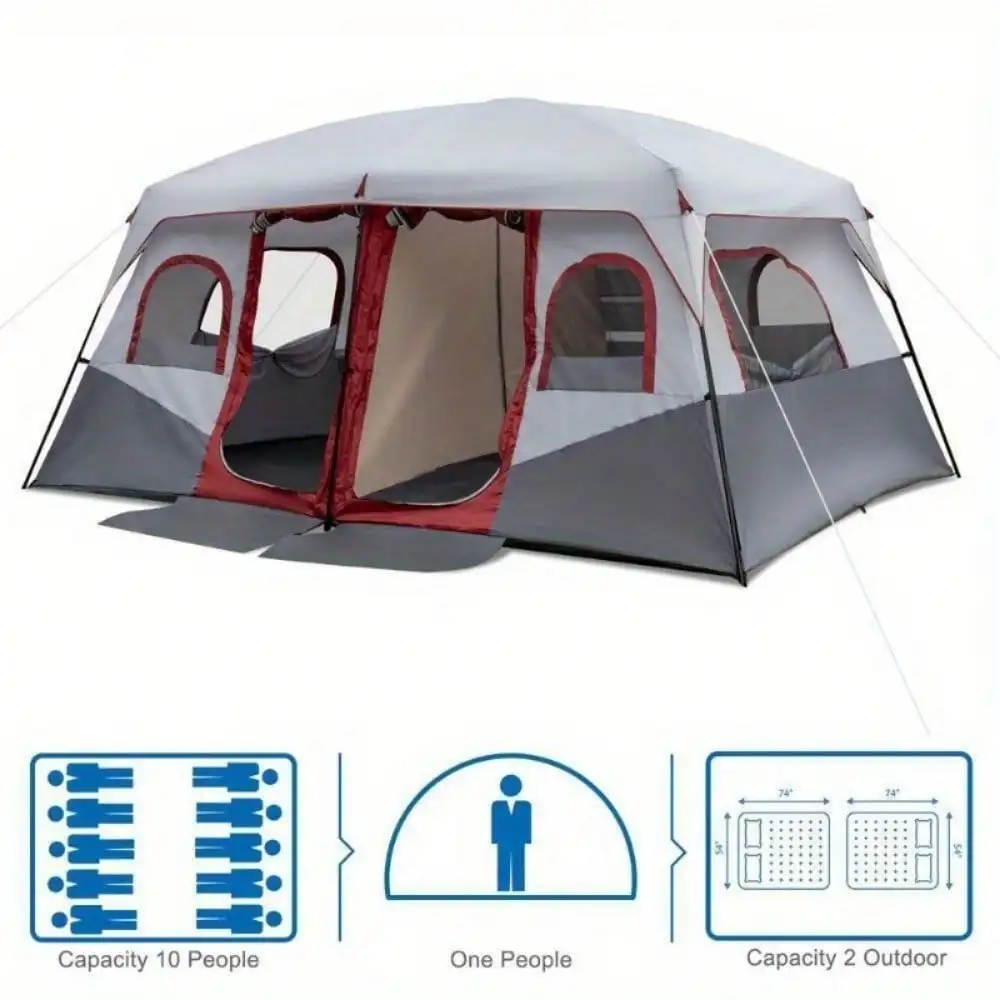
Canvas Cabin Deluxe Family Lodge
This spacious design features 230 square feet of interior space divided into three separate rooms through removable dividers. The 10oz treated canvas construction maintains durability while providing comfortable accommodations for 8-10 people. The integrated front awning creates additional covered outdoor space, and multiple doors allow family members to enter and exit without disturbing others. Despite its size, the color-coded frame system allows setup in approximately 25 minutes with two people.
Regatta Deluxe Canvas Outfitter Tent
Perfect for extended family camping, this 13×16 foot tent features a central living area with two separate sleeping rooms. The 12oz premium canvas construction ensures durability, while the 8-foot center height provides exceptional headroom throughout. Six windows with both mesh and canvas covers offer outstanding ventilation control, and the extra-wide front door accommodates large gear. The proprietary steel frame system balances strength with relatively quick 30-minute setup time.
Families looking for spacious accommodations should explore our two-room camping tent collection for options that balance comfort with durability.
5.3 Best Value Canvas Tents
Teton Sports Mesa Canvas Tent
This tent delivers surprising quality at a more accessible price point by focusing on essential features while maintaining critical material standards. The 8.5oz cotton canvas still provides excellent breathability and weather resistance, while the steel frame system offers reliable stability in moderate conditions. By simplifying the window design and using a more basic floor material, this tent reduces cost without compromising on fundamental weather protection or durability. With proper care, it still delivers 7+ years of reliable service.
Danchel Cotton Bell Tent
This bell-style tent offers exceptional value through its simplified design that requires fewer materials and components while maintaining performance. The 10.10oz cotton canvas provides standard heavy-duty protection, and the single center pole design with perimeter supports creates remarkable stability with minimal parts. By focusing on quality in essential areas like waterproofing treatments and zipper components while simplifying features like ventilation systems, this tent delivers premium performance at a more approachable price point.
Tall / Stand Up Camping Tent, Two Room Camping Tent
$407.93 Select options This product has multiple variants. The options may be chosen on the product pageHeavy Duty 4 Season Tent, Mountaineering Tent, Winter Camping Tent
$870.40 Select options This product has multiple variants. The options may be chosen on the product pageUltralight Backpacking Tent, Ultralight Dome Tent, Winter Camping Tent
Price range: $369.63 through $370.07 Select options This product has multiple variants. The options may be chosen on the product pageHeavy Duty 4 Season Tent, Ultralight Freestanding Tent, Winter Camping Tent
$3,722.66 Select options This product has multiple variants. The options may be chosen on the product page- $476.52 Select options This product has multiple variants. The options may be chosen on the product page
- $1,221.93 Select options This product has multiple variants. The options may be chosen on the product page
6. Essential Features to Consider When Buying
When investing in a heavy-duty canvas tent, understanding how different design features impact your camping experience will help you make the right choice for your specific needs:
Tent Shapes and Their Practical Impact:
Wall Tents: Rectangular designs with vertical walls maximize usable interior space, making them ideal for extended stays and accommodating cots, tables, and other furniture. Their flat roof design can collect water or snow without proper tensioning.
Bell Tents: These circular designs with a single center pole create an aesthetically pleasing and quick-to-setup shelter. The conical roof naturally sheds precipitation but creates less usable interior space along the perimeter.
Cabin Style Tents: Featuring a more complex frame system to create near-vertical walls with a peaked roof, these designs maximize headroom and typically incorporate room dividers, making them ideal for family camping.
Pyramid/Tipi Designs: Utilizing a central pole system that creates excellent wind stability and natural precipitation shedding, these tents offer a good balance of setup simplicity and weather performance.
Ventilation Systems
Despite canvas’s natural breathability, proper ventilation features are crucial for managing condensation. Look for adjustable vents at the peak, mesh windows with storm covers, and ground-level vents that create vertical air circulation. For canvas shelters withstanding rough weather, this ventilation becomes even more critical to prevent interior moisture buildup.
Entry and Exit Design
Multiple doors provide convenient access and improved airflow, while properly designed awnings protect entrances during rain. Look for high-quality YKK or similar brand zippers with weather flaps to ensure long-term reliability and weather protection.
Floor Construction
Heavy-duty tents typically feature either sewn-in floors (better weatherproofing) or detachable ground sheets (more versatility). Material thickness ranges from 16oz to 24oz PVC or polyethylene, with bathtub-style designs that curve up at the edges to prevent water entry. Removable floor designs allow better adaptation to different terrain and easier cleaning.
Weather Protection Elements
Beyond the canvas itself, features like storm flaps over zippers, reinforced guy-out points with multiple attachment options, and adjustable ventilation systems dramatically enhance performance in challenging conditions.
7. Setup & Portability Considerations
Canvas tents present unique challenges and advantages regarding transportation, setup, and mobility that differ significantly from their synthetic counterparts.
The weight reality is unavoidable – heavy-duty canvas tents typically weigh between 50-100 pounds depending on size and frame materials, compared to 10-20 pounds for synthetic alternatives. This weight necessitates vehicle transportation and often multiple people for carrying and setup.

Setup complexity varies considerably by design:
– Bell tents: Quickest setup (15-25 minutes with practice)
– Modern cabin tents: Moderate complexity (25-40 minutes)
– Traditional wall tents: Most time-intensive (40-60 minutes)
Transportation considerations include:
– Packed dimensions: Canvas tents rarely pack smaller than 28”x14”x14” and can be significantly larger
– Vehicle requirements: Most require SUV or larger vehicles; some wall tents need truck beds or roof racks
– Carrying methods: Look for models with divided components (separate poles, canvas, etc.) for easier handling
Many manufacturers have introduced features to simplify setup, including:
– Color-coded frame components
– Integrated sleeves for poles
– Pre-attached guy lines with tensioners
– Numbered connection points
Understanding proper canvas tent setup techniques can dramatically reduce setup time and improve structural stability. Most heavy-duty canvas tents benefit from having 2-3 people involved in the initial setup, though some modern designs have reduced this requirement through clever engineering.
While the weight and setup complexity represent disadvantages compared to synthetic tents, the trade-off in durability, comfort, and long-term value continues to make canvas the preferred choice for serious campers planning extended stays or frequent use.
8. Proper Care & Maintenance for Longevity
The exceptional durability of canvas tents is only fully realized with proper care. Following these maintenance practices will ensure your investment provides decades of reliable service.
The crucial first step with any new canvas tent is proper “seasoning” – the process of preparing the canvas fibers to achieve maximum water resistance. This involves:
- Setting up your tent before the first camping trip
- Thoroughly wetting the canvas with a fine mist spray
- Allowing it to completely dry in the sun
- Repeating this process 2-3 times
This procedure causes the canvas fibers to swell, tighten, and shrink slightly, closing tiny gaps in the weave and enhancing natural water resistance.
Proper drying before storage is absolutely essential to prevent mold and mildew damage. Always:
– Set up the tent completely after returning from a trip if it’s damp
– Ensure both interior and exterior surfaces dry completely
– Allow 24-48 hours of drying time in sunny, breezy conditions
– Never store a canvas tent while damp, even temporarily
For cleaning, use only mild soap solutions specifically formulated for canvas. Harsh detergents can damage waterproofing treatments and natural canvas fibers. A soft brush can be used for stubborn spots, but aggressive scrubbing should be avoided.
Long-term storage should be in a cool, dry place with the tent loosely folded rather than tightly compressed. This prevents permanent creases and allows any residual moisture to escape. Storing the tent in a breathable cotton or mesh bag rather than the original plastic packaging prevents condensation issues.
Re-waterproofing becomes necessary when you notice water no longer beading on the canvas surface. Typically needed every 1-3 years depending on use, canvas-specific water repellent treatments restore the tent’s weather resistance without compromising breathability.
For comprehensive guidance on extending your tent’s lifespan, our detailed canvas tent care guide provides step-by-step instructions for each maintenance task.
9. Comparative Analysis: Canvas vs. Synthetic Heavy-Duty Tents
Understanding the fundamental differences between canvas and synthetic tent materials helps clarify why serious outdoor enthusiasts often prefer canvas despite certain trade-offs.
| Performance Factor | Canvas Tents | Synthetic Tents |
|---|---|---|
| Weather Resistance | Excellent water resistance once properly seasoned; naturally breathable while waterproof | Immediate waterproofing with no break-in; can develop condensation issues |
| Durability | 10-15+ years with proper maintenance; highly repairable | 3-5 years typical lifespan; limited repair options |
| Temperature Regulation | 10-15°F cooler in summer heat; warmer in cold conditions | Amplifies external temperatures; requires more ventilation in heat |
| Noise Level | Naturally dampens rain and wind sounds | Can be noisy during rain or wind |
| Weight & Portability | Heavy (50-100+ lbs); requires vehicle transport | Light (5-20 lbs); many backpacking options |
| Setup Complexity | Generally more complex setup; often requires multiple people | Usually simpler, faster setup with lighter components |
| Maintenance Requirements | Higher maintenance; must be completely dry before storage | Lower maintenance; faster drying times |
| Initial Cost | Higher initial investment ($500-$2000+) | Lower initial cost ($100-$500) |
| Long-term Value | Better value over time due to longevity | Higher replacement frequency increases long-term cost |
| Environmental Impact | Lower lifetime impact due to longevity and natural materials | Higher impact from more frequent replacement and synthetic materials |
Canvas tents excel in scenarios involving:
– Extended camping trips where comfort is paramount
– Established basecamp situations with infrequent relocations
– Four-season camping, especially winter conditions
– Situations where temperature regulation is crucial
– Environments where noise reduction improves the experience
Synthetic tents offer advantages for:
– Frequent relocation or backpacking scenarios
– Situations where weight is a critical factor
– Environments with persistent high humidity
– Users with limited storage space for equipment
– Casual or infrequent camping applications
For those interested in a detailed breakdown of material performance, our comprehensive canvas vs. nylon tents comparison provides in-depth analysis of how each material performs in specific conditions.
10. Frequently Asked Questions About Heavy-Duty Canvas Tents
Q: How waterproof are canvas tents really?
A: Properly seasoned and maintained canvas tents are exceptionally waterproof. The natural fibers swell when wet, creating a tight weave that prevents water penetration while still allowing moisture vapor to escape. Modern canvas tents often include additional water-repellent treatments that enhance this natural property. Even during extended rainy periods, a quality canvas tent will remain dry inside as long as you avoid touching the walls during rainfall.
Q: How do I prevent condensation in my canvas tent?
A: While canvas naturally manages condensation better than synthetic materials, proper ventilation remains important. Use available vents, especially roof vents that allow warm, moist air to escape. Creating airflow by opening windows on opposite sides of the tent when weather permits also helps. In cold weather, insulated canvas shelters for cold weather camping with proper stove setups can effectively manage moisture through temperature control.
Q: Are canvas tents actually worth the extra weight?
A: For car camping, base camping, or any situation where frequent relocation isn’t necessary, the comfort advantages of canvas typically outweigh the portability disadvantages. The superior breathability, temperature regulation, noise reduction, and overall durability make the weight trade-off worthwhile for extended stays or frequent use.
Q: How difficult is it to set up a canvas tent alone?
A: While most canvas tents are designed for multi-person setup, many modern designs can be erected by a single person with some practice. Bell tents and certain cabin-style designs with simplified frame systems are the most solo-friendly options. Wall tents and larger family designs generally require at least two people for safe and efficient setup.
Q: Can I use a wood stove in my canvas tent?
A: Many canvas tents are designed to accommodate wood stoves when they feature a properly installed stove jack. This must be made from fire-resistant material and positioned with appropriate clearance from all canvas surfaces. Only tents specifically designed for stove use should be used with heating devices, and proper ventilation and carbon monoxide detectors are essential safety requirements.
Q: What’s the expected lifespan of a quality canvas tent?
A: With proper care and maintenance, premium heavy-duty canvas tents typically last 10-15+ years of regular use. This significantly exceeds the 3-5 year average lifespan of synthetic tents, making canvas the more economical long-term choice despite higher initial cost.
11. Making the Most of Your Canvas Tent: Accessories & Enhancements
The right accessories can significantly enhance your canvas tent’s functionality and comfort. Consider these complementary additions to maximize your camping experience:
Ground Protection Systems
– Custom-sized footprints that extend 1-2 inches inside the tent perimeter to prevent water channeling underneath
– Breathable groundsheets that allow moisture to escape from the soil while blocking rising dampness
– Interlocking foam floor tiles that provide insulation and comfort in long-term camping situations
Weather Enhancement Products
– Canvas-specific waterproofing treatments that maintain breathability
– Seam sealants designed for natural fibers
– Additional guy lines and heavy-duty stakes for extreme weather conditions
Interior Comfort Enhancements
– Insulating floor rugs that add warmth and comfort
– Thermal reflective liners that attach to the ceiling to improve heat retention
– Divider curtains for creating private spaces within larger tents
Heating Solutions
– Properly sized tent stoves with compatible chimney systems
– Carbon monoxide detectors (mandatory for any heating system)
– Heat-resistant mats for stove placement
Organization Systems
– Canvas hanging pockets and shelves that attach to tent walls
– Ceiling nets and hooks for maximizing storage space
– Custom gear lofts designed for specific tent models
For those who value interior space and comfort, exploring our tall stand-up camping tent collection can provide additional options with generous headroom for a more comfortable camping experience.
The right lighting solutions also enhance canvas tent functionality – solar-powered LED string lights work particularly well with the interior height and attachment points common in canvas designs. For heating, only use equipment specifically designed for tent use with proper safety features and ventilation systems.
12. Your Investment in Outdoor Adventure: Value Beyond Price
A premium canvas tent represents more than just a purchase – it’s an investment in countless future adventures and memories. While the initial cost may be higher than synthetic alternatives, the value equation shifts dramatically when viewed through a longer lens.
Beyond simple durability calculations, consider how the enhanced camping experience contributes to your enjoyment of the outdoors. The natural ambiance of canvas – the way it filters light, dampens sound, and creates a more comfortable microclimate – transforms camping into a more immersive and rewarding experience. Many canvas tent owners report that their shelter becomes part of the adventure itself, rather than merely functional equipment.
From an environmental perspective, choosing durable goods represents a meaningful step toward sustainability. A single canvas tent that serves for 10-15 years creates substantially less environmental impact than multiple synthetic tents purchased over the same period. This long-term canvas tent living approach aligns with the values many outdoor enthusiasts hold regarding environmental stewardship.
Perhaps most compelling is how a quality shelter enables more ambitious adventures. Weather becomes less of a limiting factor, extending your camping season and expanding possible destinations. Many families find that canvas tents become the foundation for traditions that span generations – the reliable constant that shelters everything from weekend escapes to extended wilderness explorations.
At Explore Elements, we’ve witnessed countless customers transform their outdoor experiences through the right shelter choice. Their testimonials consistently highlight how investing in quality fundamentally changed their relationship with outdoor adventure – turning challenges into comfort and limitations into possibilities.

